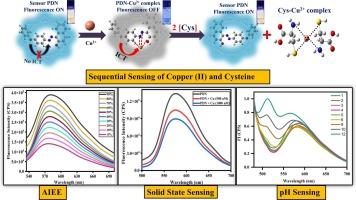A Multimode fluorescent sensor for sequential detection of Cu2+ and cysteine as well as pH sensor with real sample Applications: Extensive experimental and DFT studies
IF 4.6
2区 化学
Q1 SPECTROSCOPY
Spectrochimica Acta Part A: Molecular and Biomolecular Spectroscopy
Pub Date : 2024-11-09
DOI:10.1016/j.saa.2024.125414
引用次数: 0
Abstract
Highly responsive and optically selective (E)-1-((4-phenoxyphenyl) diazenyl)naphthalen-2-ol) sensor PDN with aggregation induced emission enhancement (AIEE) properties has been developed for the sequential detection of Cu2+ and L- Cysteine through fluorescence On-Off-On strategy. The selectivity of sensor depends on the presence of a diazo functional group and its appropriate cavity location in sensor molecule. Azo dye-based (E)-1-((4-phenoxyphenyl) diazenyl)naphthalen-2-ol) sensor PDN has been synthesized by utilizing a simple diazotization synthetic methodology that showed extraordinary AIEE behavior with bathochromic shift owing to the formation of J-aggregates. The morphology and size of aggregates were analyzed by SEM and DLS analysis, respectively. The calculated LOD of sensor PDN for Cu2+, and L-cysteine is 0.113 nM, and 84 nM, respectively. Fluorescence, UV–visible, LC-MS, 1H and 13C NMR titration were carried out to understand the interaction of sensor with Cu2+. The sensor was practically utilized in the sequential sensing of Cu2+ and Cys in real samples. Interestingly, sensor PDN was successfully employed for the sensing of a strong acid and base as well as the detection of Cu2+ ions in the solid state. Moreover, these experimental results were supported through DFT calculations.

用于连续检测 Cu2+ 和半胱氨酸的多模荧光传感器以及具有实际样品应用的 pH 传感器:广泛的实验和 DFT 研究。
本研究开发了具有聚集诱导发射增强(AIEE)特性的高响应性和光学选择性 (E)-1-((4-phenoxyphenyl) diazenyl)naphthalen-2-ol) 传感器 PDN,用于通过荧光开-关-开(On-Off-On)策略顺序检测 Cu2+ 和 L-半胱氨酸。传感器的选择性取决于重氮官能团的存在及其在传感器分子中适当的空腔位置。利用简单的重氮化合成方法合成了基于偶氮染料的 (E)-1-((4-phenoxyphenyl) diazenyl)naphthalen-2-ol) 传感器 PDN。聚合体的形态和尺寸分别通过 SEM 和 DLS 分析得出。传感器 PDN 对 Cu2+ 和 L-半胱氨酸的计算 LOD 分别为 0.113 nM 和 84 nM。为了解传感器与 Cu2+ 的相互作用,还进行了荧光、紫外可见光、LC-MS、1H 和 13C NMR 滴定。该传感器被实际应用于真实样品中 Cu2+ 和 Cys 的顺序检测。有趣的是,传感器 PDN 成功地用于了强酸和强碱的传感以及固态 Cu2+ 离子的检测。此外,这些实验结果还得到了 DFT 计算的支持。
本文章由计算机程序翻译,如有差异,请以英文原文为准。
求助全文
约1分钟内获得全文
求助全文
来源期刊
CiteScore
8.40
自引率
11.40%
发文量
1364
审稿时长
40 days
期刊介绍:
Spectrochimica Acta, Part A: Molecular and Biomolecular Spectroscopy (SAA) is an interdisciplinary journal which spans from basic to applied aspects of optical spectroscopy in chemistry, medicine, biology, and materials science.
The journal publishes original scientific papers that feature high-quality spectroscopic data and analysis. From the broad range of optical spectroscopies, the emphasis is on electronic, vibrational or rotational spectra of molecules, rather than on spectroscopy based on magnetic moments.
Criteria for publication in SAA are novelty, uniqueness, and outstanding quality. Routine applications of spectroscopic techniques and computational methods are not appropriate.
Topics of particular interest of Spectrochimica Acta Part A include, but are not limited to:
Spectroscopy and dynamics of bioanalytical, biomedical, environmental, and atmospheric sciences,
Novel experimental techniques or instrumentation for molecular spectroscopy,
Novel theoretical and computational methods,
Novel applications in photochemistry and photobiology,
Novel interpretational approaches as well as advances in data analysis based on electronic or vibrational spectroscopy.

 求助内容:
求助内容: 应助结果提醒方式:
应助结果提醒方式:


